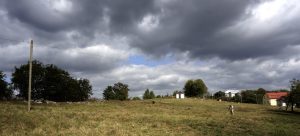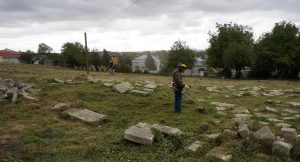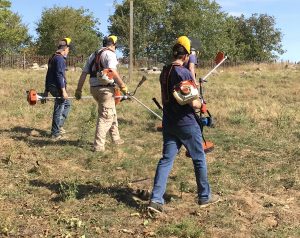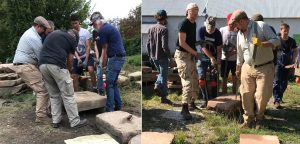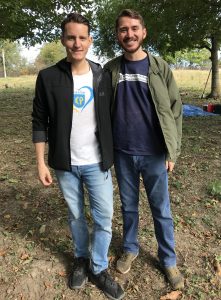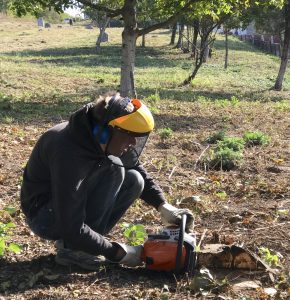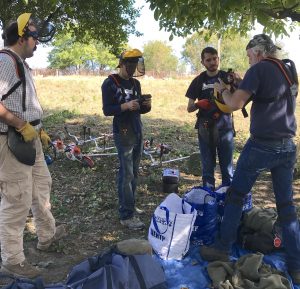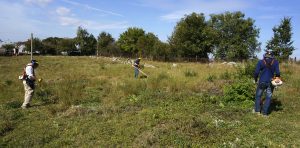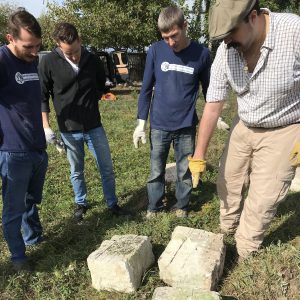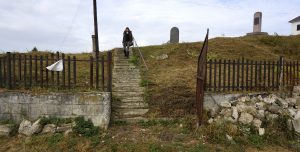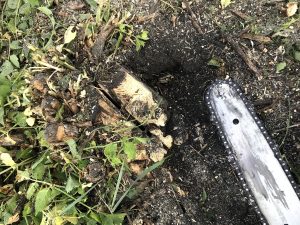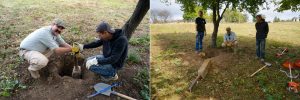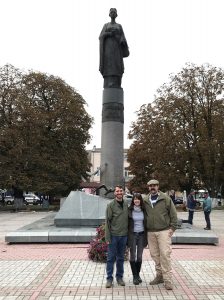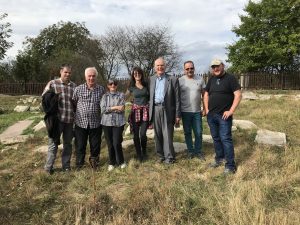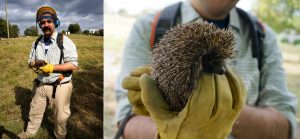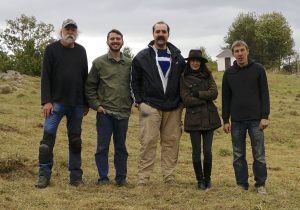This week Marla and I led a small volunteer event in Rohatyn, continuing the vegetation clearing and conditioning work in the old Jewish cemetery following several larger volunteer events earlier this year. As usual we were joined by friends and colleagues, but only a few this time so we could focus on a small number of specific tasks which did not require many hands to accomplish.
Working outdoors for many hours over three days, we were at the mercy of the weather, which changed dramatically from warm and sunny on Monday to cold, blustery, and drizzly on Wednesday. Fortunately the rain fell hard only overnight, and we were able to get everything done we had hoped to accomplish.
![]() Ця стаття також доступна українською.
Ця стаття також доступна українською.
Our Goals for This Week
As we had anticipated at the end of our previous volunteer event in August, this time we intended to do some further tidying work in the old Jewish cemetery, mostly using the power tools to address long-term issues we expect to be working on for several years, to make the cemetery easier to maintain until we can implement a larger and more permanent landscape design.
The goals were to:
- mow grass and shrubs which had grown since the last two clearing events, obscuring some of the recovered headstone fragments;
- remove fast-growing tree shoots and cut the protruding stumps from which they grow, flush to or below the ground surface;
- mow a portion of the steep slope at the front of the cemetery, to experiment with clearing methods there and to assess the ground condition; and
- continue tidying the larger plants and trees within the cemetery and at its perimeter.
We also planned to walk the entire cemetery to assess our past work, and to consider what future planning and design components to include in Marla’s Fulbright project, which is now active.
About Our Volunteers
Our volunteer crew this time was intentionally small in number, only five of us total, just enough to operate and maintain the motor tools, and to perform limited tree and bush maintenance in some of the areas which frequently need attention. As usual we had a mix of volunteers, each of whom brought interesting perspectives to the work.
We have worked alongside Pierre Richard at two volunteer work camps organized by the Lviv Volunteer Center in 2018 and 2019. During this year’s four-day LVC event in August, we worked in Lviv with Pierre clearing rubbish at the Coal Street Synagogue, sorting and moving recovered headstones at the new Jewish cemetery at Zolota Street (Yaniv), and clearing cut trees at the remains of the old Jewish cemetery behind the maternity hospital on Rappaport Street, as well as clearing rubbish and vegetation from inside and around at the synagogue ruin in Sokal. A resident of Berlin, Pierre aided the LVC during this year’s event with organization and German state financing to support the large group of German volunteers whose interest and energy drove much of the progress in the work camp. During breaks while working together in August, Pierre expressed interest in joining us to work in Rohatyn, so this week’s event was scheduled to permit him to break from his studies and work to join our project, and we were very pleased to be able to spend time with him again.
While we were with the LVC in Sokal (Lviv Oblast) last month, we also met the local Peace Corps Volunteer, Allen Gonzales-Willert, who has been teaching English there during the past year and will continue for at least another year. As has been true since our first encounters with Peace Corps Volunteers in Ukraine, Allen embodies the smart, open, and committed spirit of volunteerism which characterizes every “PCV” we meet. To this event, Allen brought enthusiasm and amusing positive perspectives on life in Sokal and western Ukraine; we are looking forward to visiting with him in Sokal again, to get an insider’s view of that interesting city.
Although he was unable to break from his teaching responsibilities in Rohatyn for more than a few hours this time, “our” Peace Corps Volunteer and frequent supporter Andrés Rodriguez still managed to provide valuable aid in arranging lodging for Allen, both lunch and a group dinner on our first day, and other local logistical tasks. It was Andrés who first informed us about Allen’s work in Sokal, making the meeting there possible. We were glad Andrés was able to join us at some meals to share his knowledge of Rohatyn developments, and to compare his perspectives with Allen’s.
Our dear friend Vasyl Yuzyshyn joined us yet again, in every kind of task in the cemetery and in town, including some specialized work for which he is our best expert. A native of the Lviv area, Vasyl has assisted us in nearly everything we do in Rohatyn, and this was already the 19th visit we have made with him this year, several of them multi-day work events like this one. We value his hard work, his clever problem-solving skills, and especially his easy smile and gentle manner which always aids our interactions with neighbors and shopkeepers in Rohatyn.
So it was a typical RJH volunteer crew, despite its small size: helping hands and hearts from Germany, Ukraine, and America, working together to secure the local Jewish heritage.
Tools and Methods
As always, we brought a selection of landscaping hand tools, including loppers and shears, which Marla used to continue shaping and taming the larger bushes and trees. We also brought the sharpened shovel we use to cut the poisonous heracleum plant at its root; fortunately it is the end of season for this pest, so we saw (and cut) only a few very small growths.
At all times, we had two to four motorized brushcutters in service all across the cemetery. Pierre and Allen used these tools exclusively, learning fast and becoming proficient already by noon on our first day; Vasyl and I used them as well, concentrating on problematic shrubs and mixed vegetation. Fortunately the weather in Rohatyn has been drier during the past several weeks, so the tough grass was less tall, dense, and wet, making it possible for the brush cutters to clear more ground quickly without becoming caked with debris. The brushcutters continue to run well, and we are now more efficient in setting them up with different cutting accessories and performing light machine maintenance. We hope these tools will continue to serve us for several more years.
Vasyl and I also spent half of each day using our two light-duty motorized saws, a gas-powered chainsaw and a battery-powered reciprocating saw. We deploy these tools primarily to cut residual stumps of shrubs and small trees cleared in 2018 and 2019. The reciprocating saw is limited in the size of stumps it can cut, and especially by its rechargeable batteries, which run flat in about 20 minutes of hard use; until we can develop a better solution, we will experiment with new higher-capacity batteries and a scheme to charge the batteries while we are on site.
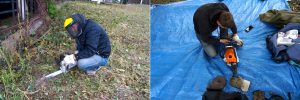
Vasyl with the chainsaw cutting below ground, and the necessary chain re-sharpening which follows. Photos © 2019 RJH.
The chainsaw is more dangerous to operate, but is capable of cutting much larger stumps and is quick at other light shrub and tree maintenance. In order to cut the stumps at or below the ground level, to eliminate trip hazards and to allow string trimmers to more easily cut new shoots without the breaking string on the hard stumps, we constantly expose the saw chain to abrasive sand and hard rocks in the soil. This means chains dull very rapidly, and the saw bars and drive gears wear quickly as well; this atypical use means we spend much more time sharpening chains, cleaning the chain drive compartment, and replacing drive components than for more common chain saw applications. Unfortunately there are many hundreds of stumps in the two Jewish cemeteries in Rohatyn; probably we will need to purchase a second chain saw and dedicate some work events primarily to this important ground conditioning work.
What We Accomplished This Week
Before heading to the old cemetery on the first day, we paused to collect seven Jewish headstone fragments in a residential part of town, about which we had been informed the prior week by Mykhailo Vorobets and Olha Blaha, as Marla reported a few days ago. It was a pleasure to return these fragments to the old cemetery, where they belong.
We had not intended to do a large amount of tree trimming and large shrub shaping, but Marla found quite a bit of old and new growth needing attention near our usual camp site and along much of the cemetery perimeter fence. This meant that the small residual pile of cut branches which was left after the most recent waste burning grew to nearly Marla’s height due to her cutting and dragging work over the three days. Vasyl also felled and cut up two dead trees in the cemetery, and of course we added many cut stumps to the new pile as well.
Likewise we had planned to mow grass primarily in the portions of the cemetery where we had not worked recently (and where grass was again growing tall). Thanks to aggressive cutting of the thick grass earlier this year, the recent dry weather, and the tireless effort of Pierre and Allen, nearly the entire cemetery was mowed again, leaving only anthills, a small number of tough shrubs, and of course the few standing headstones visible above an otherwise close-cropped surface. At the cemetery’s steep front face which drops sharply to the road, Vasyl and I experimented with the brush-cutting blade and a string head; we were able to clear a portion of the slope near the front steps, but further north the slope becomes too steep to safely stand and work. We also realized that the grass cover there, while not attractive, is helping to keep the soil in place and protected from erosion during heavy rains, so we elected to cut no further until we can evaluate this area with a landscape architect as part of Marla’s Fulbright project.
Cutting down stumps flush to or below ground level remains a nearly Sisyphean task; we continue to make progress, but as our grass-clearing effort gains ground we find more and more stumps which we need to remove. From smaller single stumps at 1cm to 5cm diameter (which the reciprocating saw can cut below ground) to larger single stumps, and clusters of woody shoots up to 20cm diameter (which only the chainsaw can deal with), we have our work cut out for us. Working part-time during this event with the power saws, Vasyl and I cut roughly a hundred stumps, but there are many hundreds (perhaps more than a thousand) still remaining. While grinding through mixed brush with a string trimmer at and adjacent to the south fence this week, I discovered well over a hundred stumps knotted through the fence rails and up the nearby slope, where last year there had been a wild thicket of shrubs; it will take a somewhat surgical effort to work in and around the fence structure plus the many rocks in the soil on this long perimeter line.
During what should have been rest breaks, Pierre challenged himself to extract a steel and concrete anchor which had been sunk deep into the cemetery soil sometime in the past decades. Because of its sharp edges, we recognized the anchor as dangerous, and we had already removed several plain steel stakes (without concrete), but this anchor seemed beyond our strength and skills. Working gradually over two days, Pierre dug carefully around the cast concrete plug, and the Vasyl helped him to work the anchor back and forth, trying to loosen it from the soil. In time it seemed it might be possible to extract the anchor, and Allen and I joined in. Eventually, with all four of us pushing and pulling, the anchor finally came out; we were astonished at how long the concrete plug was. There are at least another four of these anchors embedded in the cemetery, though the steel stake has been cut off at the ground on each of the others so they are not dangerous. If future landscaping requires that the anchors be removed, we’ll consider other ways to break the concrete below the ground surface so they don’t need to be excavated. After this anchor was removed, we refilled the hole; we’ll attend to this in future visits as well, so that no trace of the former anchor remains.
Of course the volunteer event was not all work; we had time to introduce Rohatyn to the first-time visitors, and to relax together over meals. Marla and Vasyl took Allen and Pierre to several sites important to the Jewish history of Rohatyn, including the town square, the early Jewish neighborhood and its surviving community buildings, both cemeteries, and the south mass grave. They also visited the 400-year-old wooden Holy Spirit church, a UNESCO-recognized monument of world heritage. At the end of both days (following much-needed showers!), all six of us including Andrés gathered for dinner together and a chance to share past experiences, future plans, plus quite a bit of humor. Every one of our volunteer events enables us to work with wonderful people from many places; we wish we could spend more time with them all.
Visitors, and a Surprise
No cemetery volunteer event would be complete without some friendly visitors, from neighbors to far-away foreigners. This time we welcomed a family from Israel with roots in Kniahynychi, a village not far to the west of Rohatyn and with many historical Jewish family connections to Rohatyn. The group was led by our friend Alex Trostyanitsyn, and accompanied by a Lviv university professor and historian of Kniahynychi. Marla spoke with them about the former Jewish community of Rohatyn and its connections to other area towns and villages, and about our project in town. The tour group also visited Novi Strilyshcha, another of their ancestral towns.
While cutting grass one day with the string trimmer, Pierre encountered a small hedgehog; we had probably woken the nocturnal creature with our noisy machines. The hedgehog is probably more of a resident than a visitor, so after a few photographs and a lot of smiles, Pierre placed it carefully just outside the cemetery fence at the border of a large adjacent garden. During another small volunteer event in the old Jewish cemetery last year at this time, our friend Jonathan Pamel discovered two hedgehogs in the path of oncoming string trimmers, and gently moved them to a safer place in the cemetery.
Looking Forward
Cooler weather and less sunshine means wild growth will slow now, so we anticipate needing to do less (or no) short-term cutting of vegetation. For the cool and cold seasons, we will focus our landscape maintenance on long-term concerns such as clearing stumps. The grass-cutting effort just completed will help us locate stumps before winter, and as we learned this year, when the snow recedes next year the stumps will also be easy to find, until warmer weather brings the grasses back.
As noted previously, we do not currently have a solution for the large number of anthills in the old cemetery (and at most of the Jewish heritage sites); this issue needs further study. On the other hand, we did make further progress in removing hard debris from the cemetery this week, including discarded bottles and garbage; we still have several piles of waste concrete and building rubble to gather and remove.
Clearing a portion of the old Jewish cemetery and managing the recovered Jewish headstones there is a preliminary step in Marla’s Fulbright project for 2019-2010; we can consider this step complete now. The majority of Marla’s effort for the next nine months will be marshaling resources and expertise to consider design options for rehabilitation of the cemetery, conservation and presentation of the recovered headstones, and documenting the lessons learned in a format which we and others can apply to future heritage projects in the region.

